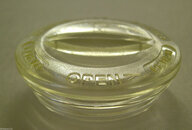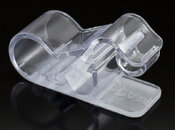So it looks like this....
If I was going to use an additive process I'd look at SLA. I worked in the additive group at GE and we used SLA for 'finished' prototypes, before growing things out of metal. I don't know anything about material properties, but SLA is grown from a liquid bath and solidified by light. I feel like it's more homogeneous and continuous (ie, stronger) in addition to having the best surface finish of what I've seen of the plastic technologies.
Here's a pic of an SLA clip I found online. If you Google "SLA surface finish" you'll get similar pics.
Machining that thing could be a pain - you might have to machine the bottom/threads then flip it and do the top. Then someone's gotta spend time and figure out fixtures, datums, etc.
Another option could be to machine (or build) a 2-part mold: a bottom with the threads, and a top that has a hole (gate) for filling with epoxy. Coat the mold (insides and interfacing surfaces) with mold release, clamp top to bottom, and fill with epoxy. When it cures you separate the top/bottom and unscrew your part from the bottom.
The advantage is that you don't have to machine around that lip (which is what I think will drive you to having to flip and re-fixture the part) and you can use materials that are incredibly simple to machine. You could have someone with a hobby machine carve that out for you. There's no datums or fixturing to worry about, just a block of material and some clamps. The disadvantage is having to make the 'negative' of the model - which in my experience has been much more difficult than it should be (maybe this part is simple enough).
SLA would be much, much easier






